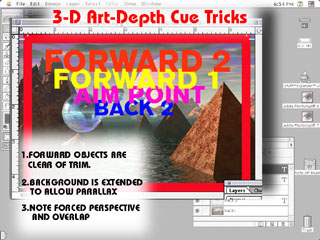



 |
|
| How it works! |
|
|
|
|
|
Layered Art Preperation
Conventional graphics can be converted to effectively display the illusion of depth when certain points are followed during art preparation. Sometimes called 2D3D Conversion. 1. Backgrounds must be wider than the final image to account for parallax (i.e. unit final size= 8" x 10" background should be 9" X 10"). As a general rule add atleast 1/2" to the left and right sides of the background. If you are unsure of how much extra to include, remember that more is better as photo-retouch work or cloning can incur additional creative costs. 2. If possible, backgrounds should avoid solid colors or horizontal stripes. these two situations do not provide a depth reference to the observer. An alternative to a solid color would be to add texture such as crumpled paper to the color. 3. If objects are "cut out" of the background to be layered with the background, the removed area of the background must be cloned or retouched to cover the void area. 4. Elements that are supposed to project forward of the aimpoint or surface should not encroach or bleed beyond the trim. If the element is trimmed, confusing depth cues will be observed and the illusion of dimension on that element will be lost. 5. Elements that overlap even slightly are good depth cues and will enhance the illusion of depth. 6. Forcing perspective can enhance the illusion of depth. An example of forced perspective is where objects appear to get smaller the farther they are from the observer. 7. Psychologically, cooler colors tend to recede and warmer colors tend to project. 8. Logos or important type/copy should be composed to be on or near the aimpoint. 9. The same rules for type, resolution, and client approval apply. 
Copyright (C) 2003 Digillax Systems. All rights reserved. | ||


 |
Last update Friday, November 26, 2010 05:20:35 AM